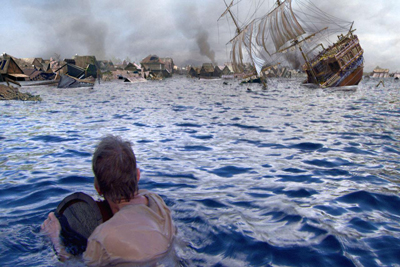
Located on a small island off the southeast coast of Jamaica, Port Royal was founded by the Spanish in 1494. But for centuries before that, the Native Americans, known as Taino, used the area during their fishing expeditions and called it Caguay.
Although the Spanish, under the leadership of Christopher Columbus, first landed in Jamaica in 1494, the settlement started only in 1509, when Juan de Esquivel, a Spanish officer, brought a group of settlers who were in search of new lands and valuable resources, like gold and the like. They did not change the name of the area, and instead of using it as a port, started to cultivate and process the sugar cane. After being controlled by the Spanish for more than 150 years, it was captured by an English expeditionary force in 1655 during the invasion of Jamaica, and by 1659 two hundred houses, shops and warehouses were built around the fort. Initially, the English retained its original name and called it Cagway, but subsequently changed the name to Port Royal.

As the English lacked manpower, the then Governor Edward D’Oyley invited the Brethren of the Coast to settle in the Pot Royal as a means to solve the defense concern.
The Brethren, originally a group of pirates, were forced to become pirates after being robbed by the Spanish and subsequently concentrated their attacks on Spanish shipping, and becoming the major threat to the town. As they became legal privateers, they started to attack and plunder the poorly-defended Spanish ports of the region, and spend their riches on hedonistic lifestyles, oriented toward earthly pleasure and enjoyment. Apart from that, money made from trading slaves, sugar and logwood turned Port Royal into unhinged and unbridled heaven of alcohol, unaccounted money, and sex. With the abundance of bars and brothels, smuggling, and debauchery, Port Royal became notorious throughout the New World by the 17th century and earned the name as the most wicked and sinful city in the world.

Small scale earthquakes were not uncommon in the area, and a medium-scale tremor had toppled three buildings in 1688. But the situation changed forever when four years later, late in the morning on 7 June 1692, a massive earthquake estimated at a 7.5 magnitude struck the island. It was believed that the island of Port Royal was made of bedrock. But the city was largely built on sand, and the relatively loosely packed soil instantly turned almost liquid during the quake, and many buildings, including two forts, literally sank into the ground. The quake was followed by a large tsunami that dragged half of the Port Royal under 40 feet of water. At the end of the devastating calamity, about 33 acres of the city disappeared under the sea, hundreds of buildings were toppled, and about 3000 people lost their lives. In the aftermath, there was little respite for those who survived due to widespread looting and hooliganism that prevailed in the region, and thousands more died in the following weeks due to sickness and injury. Since the catastrophic disaster, the city of sin had been racked several times by fire, earthquake, and hurricanes. Finally, most of the residents left the city, and the English decided to close their naval station in Port Royal. What was left of the port city was destroyed by Hurricane Charlie in 1951, leaving only a few of the original buildings.


Today, most of the remains of the lost 17th-century city lying under 40 feet of water has become a virtual archaeological park, which can be termed as a gold mine, filled with pieces of history that tell the story of everyday life in the earliest days of English occupation. Since the 1950s, explorers have been diving to explore and make a catalog of the submerged city. Till today, thousands of artifacts have been recovered, which are supposed to be showcased in a local museum. However, many of the items that were recovered over the years are housed at the Museum of History and Ethnography at the Institute of Jamaica in Kingston. One of the most interesting items, a pocket-watch dated 1686, was discovered by Edwin Link in 1969, which stopped exactly at 11.43. The Archaeology Division of the Jamaica National Heritage Trust has already completed a sonar survey of the submerged city that revealed a sunken pirate ship in the Kingston Harbour. As most of the buildings of Port Royal just slipped into the sea as it was, in a more or less undisturbed condition, it has often been compared to the lost city of Pompeii for its archaeological wonders and was designated as a National Heritage Site in 1999.